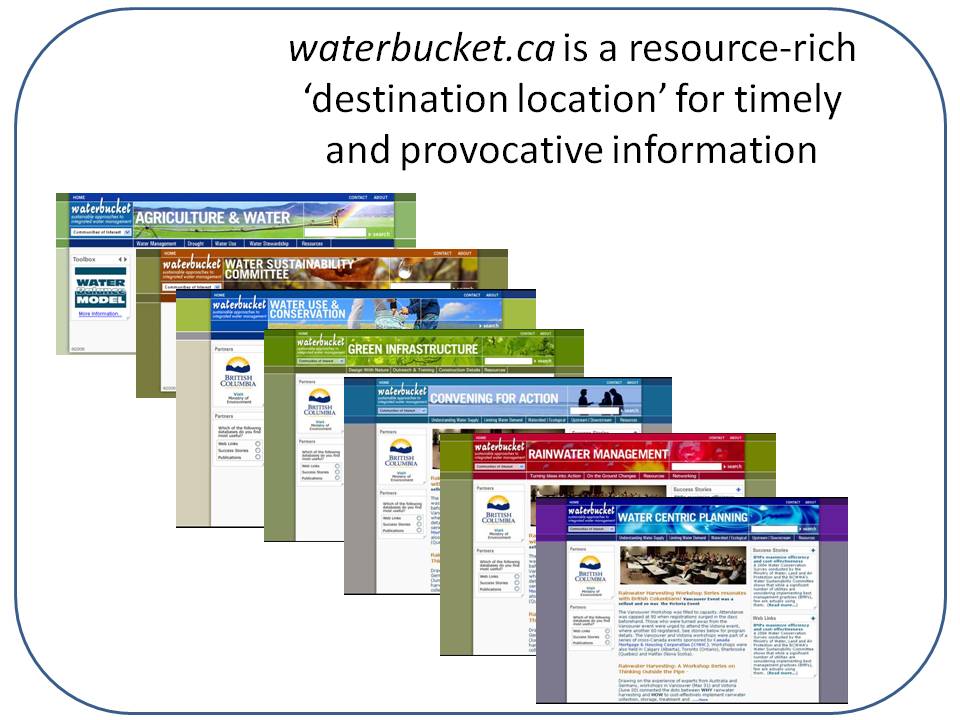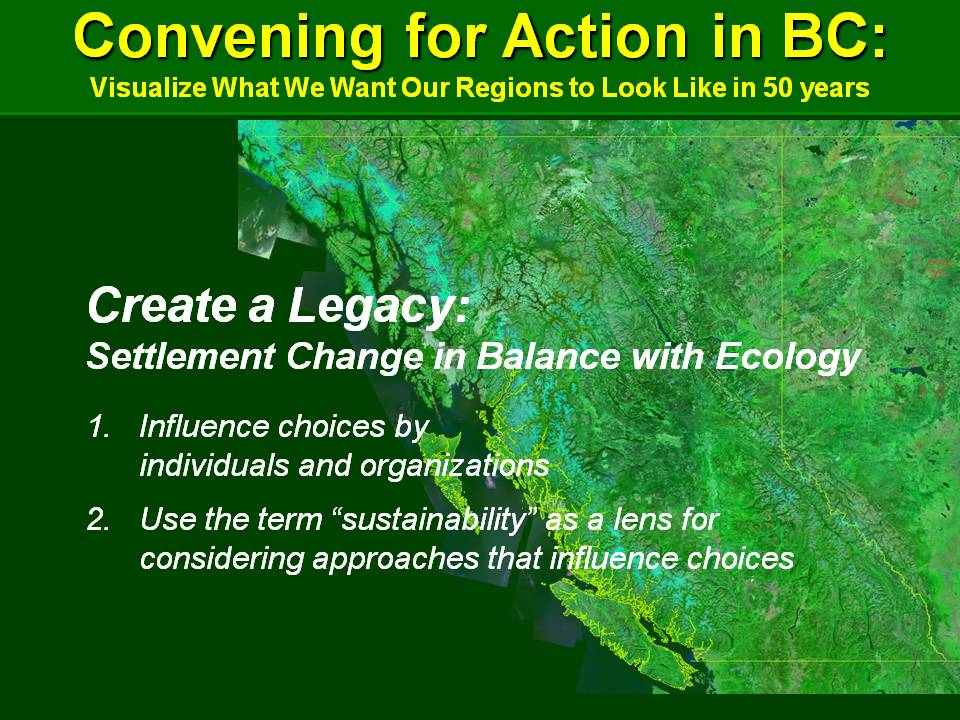Water Sustainability Action Plan funders laud value of Water Bucket website
Google Analytics measures success of website in reaching target audiences
The Water Bucket Website Partnership reports a 45% increase in user visits after two years of Google Analytics monitoring. The rolling 6-month average exceeds 4000 visits per month.
“We attribute this large jump to the cumulative enhancements that the partnership has been systematically implementing over the past two years. These enhancements encompass both technology fixes and content evolution,” states Mike Tanner, Chair.
Why Water Bucket is Successful
 “The financial support provided by our core funders, namely the Province of British Columbia and the Real Estate Foundation of British Columbia has enabled the success of the website. The Ministry of Community and Rural Development, for example, funded a third party evaluation in 2008 that then provided direction for a series of technology fixes. Because we had Google Analytics in place, we could measure the resulting surge in visits,” continues Mike Tanner.
“The financial support provided by our core funders, namely the Province of British Columbia and the Real Estate Foundation of British Columbia has enabled the success of the website. The Ministry of Community and Rural Development, for example, funded a third party evaluation in 2008 that then provided direction for a series of technology fixes. Because we had Google Analytics in place, we could measure the resulting surge in visits,” continues Mike Tanner.
Content, Content, Content
“Another critical success factor is that Water Bucket comprises a family of eight communities-of-interest. These mirror the elements of the Water Sustainability Action Plan for British Columbia, in particular the Water Balance Model. So there are multiple pathways to the Water Bucket; yet ultimately everything is linked.”
“It is content that makes the Water Bucket a preferred destination. So we have created ‘homepages’ for many of our partners, such as the ones for the Vancouver Island Coordinating Team and Integrated Resource Recovery. News-style stories create interest in Action Plan programs and events. To get the word out, we work with our partners to craft email-type news releases that are complete with embedded links to Water Bucket stories. We are finding that these news releases are taking on a life of their own.”
Audience Response
“Google Analytics has enabled us to monitor how our target audiences respond to weekly e-news releases. We are always learning and adapting based on feedback from the user community.”
“We have numerous anecdotes that illustrate the value that people are getting from Water Bucket. Two words that keep coming up in conversations are ‘engaging’ and ‘inspirational’. From what they are telling us, people like and value what they are reading on Water Bucket,” summarizes Mike Tanner.
Connect the Dots Between Land & Water
 “The vision of the Real Estate Foundation is that we will be a pivotal connection in making land use knowledge and practice in British Columbia a model for the world,” states Karin Kirkpatrick, Chief Executive Officer. “Because the Foundation has helped generate content on Water Bucket, this has allowed us to collaboratively frame this challenge for land and water practitioners: What is our land ethic, and how can we view the context differently?”
“The vision of the Real Estate Foundation is that we will be a pivotal connection in making land use knowledge and practice in British Columbia a model for the world,” states Karin Kirkpatrick, Chief Executive Officer. “Because the Foundation has helped generate content on Water Bucket, this has allowed us to collaboratively frame this challenge for land and water practitioners: What is our land ethic, and how can we view the context differently?”
“Connecting people to the landscape is important. Water Bucket has a diversity of readers, including a wide range of practitioners. This shows that there is ongoing and increasing value in the way Water Bucket has become a web destination of choice.”
Framework for Action on the Ground
The Real Estate Foundation perspective is echoed by Glen Brown, Executive Director with the Ministry of Community & Rural Development: “As an  outreach vehicle, Water Bucket has been effective in raising broader awareness of the relevance and the significance of the goals and objectives of two provincial programs, namely Living Water Smart and the Green Communities Initiative. In fact, both have ‘second homes’ on Water Bucket to complement the content on provincial government sites.”
outreach vehicle, Water Bucket has been effective in raising broader awareness of the relevance and the significance of the goals and objectives of two provincial programs, namely Living Water Smart and the Green Communities Initiative. In fact, both have ‘second homes’ on Water Bucket to complement the content on provincial government sites.”
“Also, by telling the stories of what the champions are doing on the ground, Water Bucket is helping practitioners to articulate a vision of what the regions of our province can look like if local governments prepare communities for climate change, choose to live water smart, and strive to build greener communities. The future desired by all will be created through alignment of local actions with provincial and regional policies.”
Fully Integrated Websites
 “The Water Bucket and the Water Balance Model are companion websites. In fact, they are inseparable in a number of ways – for example, Water Bucket resides on the Water Balance Model server,” states Ted van der Gulik, Senior Engineer with the Ministry of Agriculture & Lands, and Chair of the Inter-Governmental Partnership that is responsible for the Water Balance Model.
“The Water Bucket and the Water Balance Model are companion websites. In fact, they are inseparable in a number of ways – for example, Water Bucket resides on the Water Balance Model server,” states Ted van der Gulik, Senior Engineer with the Ministry of Agriculture & Lands, and Chair of the Inter-Governmental Partnership that is responsible for the Water Balance Model.
“At another level of integration, Water Balance Model is the tool and Water Bucket is the vehicle for telling our story about how to achieve a ‘light hydrologic footprint’ in the built environment. Together they help planners and designers wrap their minds around how to implement ‘green solutions’ on the ground.”
Twin Engines of the Action Plan
“In Beyond the Guidebook 2010, the Water Bucket and the Water Balance Model are  described as the twin engines driving an outreach and continuing education program, one that is fully integrated under the umbrella of the Water Sustainability Action Plan,” elaborates Mike Tanner. “The Water Bucket – Water Balance Model synergy is underscored by the Google Analytics data for Water Bucket communities-of-interest.”
described as the twin engines driving an outreach and continuing education program, one that is fully integrated under the umbrella of the Water Sustainability Action Plan,” elaborates Mike Tanner. “The Water Bucket – Water Balance Model synergy is underscored by the Google Analytics data for Water Bucket communities-of-interest.”
- To Learn More: Click on Convening for Action in British Columbia: Water Balance Model and Water Bucket Website are the twin engines for Outreach & Continuing Education Program
“In terms of page views, Water Bucket averages over 10,000 per month. The most popular COI is Rainwater Management with a 22% share. This ‘homepage’ is the primary communication platform for the Water Balance Model. In second place is the Green Infrastructure COI at 19%. It is the communication vehicle and ‘homepage’ for the Green Infrastructure Partnership.
Communicating a Consistent Message
“The Rainwater and Green Infrastructure COIs are complementary in communicating a consistent message. They explain why and how BC communities can achieve water sustainability by implementing green infrastructure policies and practices,” adds Ray Fung, Chair of the Green Infrastructure Partnership.
“Because we believe use of the Water Balance Model can facilitate better land use  decisions and ‘greener design’, the Green Infrastructure Partnership formally embraced the tool in 2005. This was an outcome of a consultation workshop that was organized in collaboration with the Regional Engineers Advisory Committee representing Metro Vancouver municipalities.”
decisions and ‘greener design’, the Green Infrastructure Partnership formally embraced the tool in 2005. This was an outcome of a consultation workshop that was organized in collaboration with the Regional Engineers Advisory Committee representing Metro Vancouver municipalities.”
“Through a joint outreach and continuing education program, we collaborate with the Inter-Governmental Partnership to promote use of the Water Balance Model province-wide. We do this through flagship events such as the 2009 Surrey Forum. Water Bucket provides value and enables us to tell our story in a way that no other medium can currently provide.”
Convening for Action in British Columbia
“The Convening for Action COI rounds out the top three ‘homepages’. It has a 16% share of the page views is. It is the homepage for a ‘made in BC’ process that the Action Plan partners have branded as Convening for Action in BC. The aim of the partners is to move from talk to action by developing tools, providing training and building capacity. Water Bucket is an integral and essential part of program delivery,” concludes Mike Tanner.





